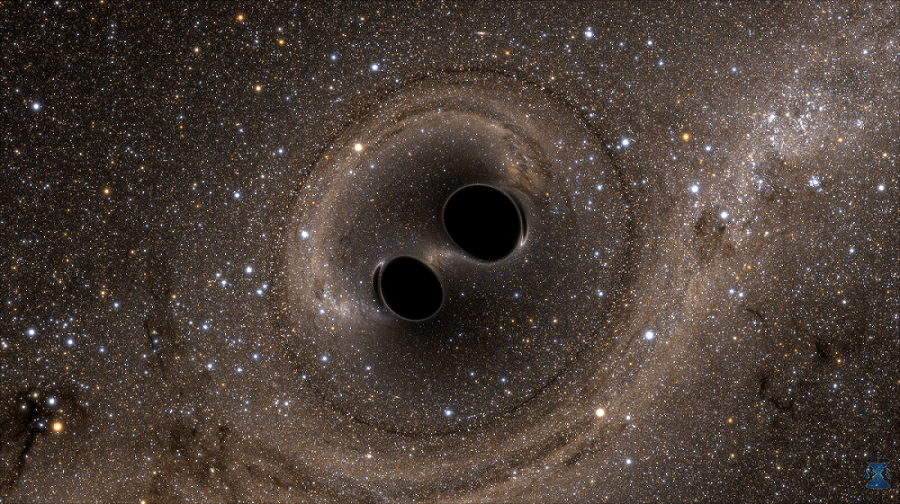The first-ever detection of
gravitational waves
(which took place in
September of 2015
) triggered a revolution in astronomy. Not only did this event confirm a theory predicted by
Einstein's Theory of General Relativity
a century before, it also ushered in a new era where the mergers of distant black holes, supernovae, and neutron stars could be studied by examining their resulting waves.
In addition, scientists have theorized that black hole mergers could actually be a lot
more common than previously thought
. According to a
new study
conducted by pair of researchers from Monash University, these mergers happen once every few minutes. By listening to the background noise of the Universe, they claim, we could find evidence of thousands of previously undetected events.
Their study, titled "
Optimal Search for an Astrophysical Gravitational-Wave Background
", recently appeared in the journal
Physical Review X
. The study was conducted by Rory Smith and Eric Thrane, a senior lecturer and a research fellow at Monash University, respectively. Both researchers are also members of the
ARC Center of Excellence for Gravitational Wave Discovery
(OzGrav).
[caption id="attachment_139033" align="aligncenter" width="555"]
Drs. Eric Thrane and Rory Smith. Credit: Monash University
[/caption]
As they state in their study, every 2 to 10 minutes, a pair of stellar-mass black holes merge somewhere in the Universe. A small fraction of these are large enough that the resulting gravitational wave event can be detected by advanced instruments like the Laser Interferometer
Gravitational-Wave Observatory
and Virgo observatory. The rest, however, contribute to a sort of stochastic background noise.
By measuring this noise, scientists may be able to study much more in the way of events and learn a great deal more about gravitational waves. As Dr Thrane explained in a Monash University
press statement
:
Drs Smith and Thrane are no amateurs when it comes to the study of gravitational waves. Last year, they were both involved in a major breakthrough, where researchers from
LIGO Scientific Collaboration
(LSC) and the
Virgo Collaboration
measured gravitational waves from a pair of
merging neutron stars
. This was the first time that a neutron star merger (aka. a kilonova) was observed in both gravitational waves and visible light.
The pair were also part of the Advanced LIGO team that made the first detection of gravitational waves in September 2015. To date, six confirmed gravitational wave events have been confirmed by the LIGO and Virgo Collaborations. But according to Drs Thrane and Smith, there could be as many as 100,000 events happening every year that these detectors simply aren't equipped to handle.
[caption id="attachment_131150" align="aligncenter" width="580"]
Artist's impression of merging binary black holes. Credit: LIGO/A. Simonnet.
[/caption]
These waves are what come together to create a gravitational wave background; and while the individual events are too subtle to be detected, researchers have been attempting to develop a method for detecting the general noise for years. Relying on a combination of computer simulations of faint black hole signals and masses of data from known events, Drs. Thrane and Smith claim to have done just that.
From this, the pair were able to produce a signal within the simulated data that they believe is evidence of faint black hole mergers. Looking ahead, Drs Thrane and Smith hope to apply their new method to real data, and are optimistic it will yield results. The researchers will also have access to the new OzSTAR supercomputer, which was installed last month at the
Swinburne University of Technology
to help scientists to look for gravitational waves in LIGO data.
This computer is different from those used by the LIGO community, which includes the supercomputers at CalTech and MIT. Rather than relying on more traditional central processing units (CPUs), OzGrav uses graphical processor units - which can be hundreds of times faster for some applications. According to Professor Matthew Bailes, the Director of the OzGRav supercomputer:
What has been especially impressive about the study of gravitational waves is how it has progressed so quickly. From the initial detection in 2015, scientists from Advanced LIGO and Virgo have now confirmed six different events and anticipate detecting many more. On top of that, astrophysicists are even coming up with ways to use gravitational waves to learn more about the astronomical phenomena that cause them.
All of this was made possible thanks to improvements in instrumentation and growing collaboration between observatories. And with more sophisticated methods designed to sift through archival data for additional signals and background noise, we stand to learn a great deal more about this mysterious cosmic force.
Further Reading: Monash, Physical Review X
 Universe Today
Universe Today
